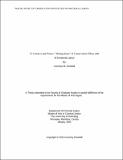| dc.contributor.author | Dowdall, Courtney M. | |
| dc.date.accessioned | 2023-03-27T16:51:51Z | |
| dc.date.available | 2023-03-27T16:51:51Z | |
| dc.date.issued | 2023-01 | |
| dc.identifier.citation | Dowdall, Courtney M. To Conserve and Protect: “Making Sense” of Conservation Officer uses of Emotional Labour; A Thesis submitted to the Faculty of Graduate Studies in partial fulfilment of the requirements for the ... Master of Arts in Criminal Justice, The University of Winnipeg. Winnipeg, Manitoba, Canada: University of Winnipeg, January 2023. DOI: https://doi.org/10.36939/ir.202303271145. | en_US |
| dc.identifier.uri | https://hdl.handle.net/10680/2063 | |
| dc.description.abstract | Given the unique role that conservation officer’s play in our society, it is critical that researchers better understand factors that may influence the activities and behaviours of the individuals tasked with dealing with complex emotions of others, ensuring the safety of Canada’s backcountry wilderness, all while maintaining a tough persona and enforcing the law (Moreto et al., 2015; Moreto, 2016). Hochschild’s (1983) concept of “emotional labour” is employed within this document to explore the extent to which conservation officers rely on their ability to deal with complicated emotions, within themselves and those of individuals they encounter. Due to the limited literature exploring the nexus between conservation officers and emotional labour, a grounded theoretical approach was selected to accommodate the emerging nature of these concepts. Identifying the driving factors in conservation officer behaviour provides avenues to better understand the feasibility, applicability, and likelihood of success when introducing policy aimed at improving officer mental health (Moreto et al., 2015). This study is based on twelve in-depth qualitative interviews and six commentated walks with members from provincial and private parks in British Columbia, Canada. Within it, I will explore how conservation officers engage in emotional labour, as well as its impact. The results reveal how managing emotions according to the organizationally mandated display rules can affect an officer’s well-being, and it highlights the need for future research to enable park enforcement organisations to deal more effectively with work-related stress. | en_US |
| dc.description.sponsorship | "Thank you to the Social Sciences and Humanities Research Council of Canada for awarding this research with the Joseph Bombardier Scholarship valued at $17,500 and the Mobilising Insights in National Defence scholarship for Indigenous students, also valued at $17,500." | en_US |
| dc.language.iso | en | en_US |
| dc.publisher | University of Winnipeg | en_US |
| dc.rights | info:eu-repo/semantics/openAccess | en_US |
| dc.subject | Conservation Officers | en_US |
| dc.subject | Emotional Labour | en_US |
| dc.subject | Stress | en_US |
| dc.subject | Investigative Work | en_US |
| dc.subject | Law Enforcement | en_US |
| dc.subject | Trauma | en_US |
| dc.subject | Hauntology | en_US |
| dc.subject | Violence | en_US |
| dc.subject | Pictorial Analysis | en_US |
| dc.subject | Member Reflections | en_US |
| dc.subject | Commentated Walks | en_US |
| dc.subject | Sensemaking, and Coping | en_US |
| dc.title | To Conserve and Protect: “Making Sense” of Conservation Officer uses of Emotional Labour | en_US |
| dc.type | Thesis | en_US |
| dc.description.degree | Master of Arts in Criminal Justice | en_US |
| dc.publisher.grantor | University of Winnipeg | en_US |
| dc.identifier.doi | 10.36939/ir.202303271145 | en_US |
| thesis.degree.discipline | Criminal Justice | |
| thesis.degree.level | masters | |
| thesis.degree.name | Master of Arts in Criminal Justice | |
| thesis.degree.grantor | University of Winnipeg | |

